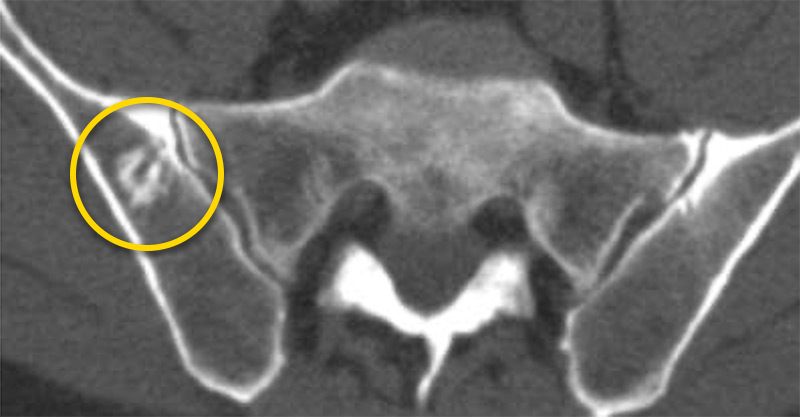A bone island is an isolated piece of compact bone that rarely causes symptoms. You won’t feel it. Usually, bone islands grow no larger than 2 centimeters. Occasionally, your healthcare provider might order a biopsy to make sure it’s a bone island and not some other type of bone lesion.
Advertisement
Cleveland Clinic is a non-profit academic medical center. Advertising on our site helps support our mission. We do not endorse non-Cleveland Clinic products or services. Policy

A bone island (enostosis) is a noncancerous (benign) lesion that rarely causes symptoms. It’s a tiny, dense piece of bone that grew within another section of your bone — specifically, a piece of compact (cortical) bone within cancellous bone (a network of spongy bone tissue). The bone is isolated, like it’s on an island. The compact bone doesn’t damage the cancellous bone and doesn’t usually cause pain.
Advertisement
Cleveland Clinic is a non-profit academic medical center. Advertising on our site helps support our mission. We do not endorse non-Cleveland Clinic products or services. Policy
Bone islands are typically not dangerous. They’re not cancerous, and rarely cause any symptoms.
Bone islands can appear anywhere in your skeleton, but they’re most common in your:
Anyone can develop a bone island, but adults are more likely to get bone islands than children.
Bone islands rarely cause symptoms. It shouldn’t affect your body at all.
Experts are unsure what causes bone islands. They may be present at birth (congenital) or may develop over time.
You may have a bone island and not be aware of it. They rarely cause symptoms (asymptomatic). Some people report pain, but it’s rare.
A bone island is a round, oval or oblong lesion with thorn-like “fingers” on its margins. They usually grow slowly and rarely get larger than 2 centimeters in diameter. A bone island that’s larger than 2 centimeters is called a giant bone island.
If you have a bone island, you probably don’t feel it. They often don’t cause any symptoms at all. Rarely, someone will feel pain.
Bone islands don’t go away on their own. And, since they don’t cause symptoms, there’s generally no reason to remove it.
Healthcare providers usually discover a bone island by accident. Often, they’re taking an X-ray or CT scan for a completely different reason and notice the bone island. They can tell it’s a bone island by the shape, type of bone and density of the tissue.
Advertisement
A bone island sometimes looks similar to other types of lesions or benign bone tumors. (You might hear your healthcare provider refer to this as a “differential diagnosis.”) These include:
Your healthcare provider should determine if you have a bone island or a lesion or tumor that looks like one.
You don’t need any treatment for your bone island unless it’s causing you pain. If you’re in pain, your healthcare provider might order a repeat imaging study like a CT scan to see if your bone island has grown. If it gets larger by 50% in one year or 25% in six months, your healthcare provider might do a biopsy (retrieve a sample) of your tissue.
Once your tissue is retrieved, your healthcare provider checks to see if it’s a bone island or another type of lesion.
If your healthcare provider discovers a bone island, and you have a history of malignant (cancerous) growths, they might do a biopsy right away.
The outlook if you have a bone island is very positive. Only rarely does it cause pain. You don’t need to go through any treatments or follow up with your healthcare provider.
Neither you nor your healthcare provider can prevent a bone island. But a bone island causes no harm. There’s no reason to try preventing one.
You don’t need to do anything about your bone island. There aren’t any treatments.
Contact your healthcare provider if you feel any pain coming from your bone island. Pain is very unlikely.
Bone islands are benign, which means they aren’t cancerous. Talk to your healthcare provider if you’re concerned about cancer or other conditions.
Bone islands have a distinctive appearance visible on an X-ray or CT scan, and they’re made of a specific type of bone. They’re not usually misdiagnosed.
An enostosis is one bone island. The term “enostoses” means several bone islands. Multiple enostoses are also known as spotted bone disease (osteopoikilosis). Spotted bone disease is rare and also asymptomatic.
A bone island is one of the “don’t touch” skeletal lesions. It isn’t touched because it doesn’t need to be. If you have pain, or if you’re concerned about a misdiagnosis, contact your healthcare provider. They’ll listen to your concerns and determine if you need treatment.
Advertisement
Cleveland Clinic’s primary care providers offer lifelong medical care. From sinus infections and high blood pressure to preventive screening, we’re here for you.

Last reviewed on 01/28/2022.
Learn more about the Health Library and our editorial process.